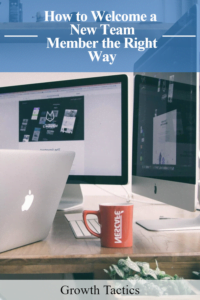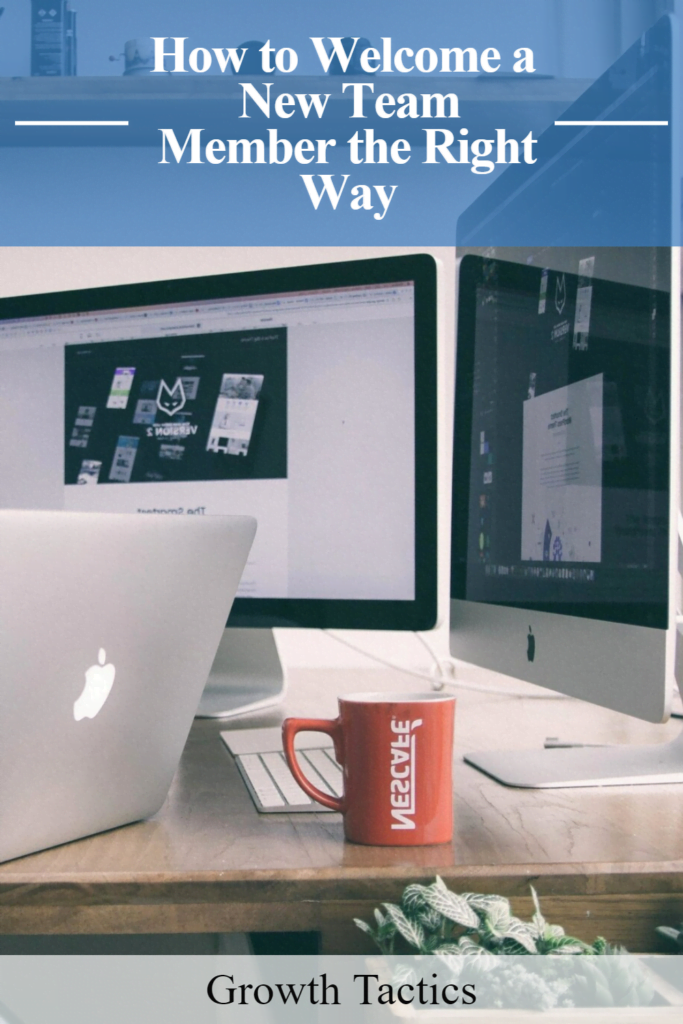A good welcome makes people feel valued and excited. It helps them understand their job better and connect with the team faster. I remember starting a job where they had everything ready for me. It felt great!
But a poor welcome? That can leave someone feeling lost and unsure. I’ve been there too, and it’s not fun.
So, think about what makes your company special. Share that with new hires. Show them how they fit in.
A good welcome shows you care. It sets the stage for a great working relationship. And isn’t that what we all want?

Jump To Section
Start With a Warm Welcome Message
Welcoming a new employee starts with a thoughtful message to make them feel excited and comfortable in their new role. Send a welcome email or handwritten card on their first day to break the ice and highlight some key points:
Express how thrilled you are to have them join the team. Mention looking forward to working together and getting to know them better. This sets a warm, welcoming tone from day one.
Note any unique strengths, skills, or experience they bring that will be valuable to the team. This shows you recognize their individual talents.
Share your confidence that they will be a great addition who will help the team continue to thrive. This reinforces they made the right decision to join.
Highlight your open-door policy for any questions they have to help them feel supported. Let them know you and the team are there to help them ramp up and succeed in their new role.
Wish them congratulations and a warm welcome again to make it personal.
Starting the relationship with a thoughtful note helps the new hire feel welcomed, engaged, and excited to work with you and the team. It’s a small touch that makes a big impact.
Introduce The New Member to the Team
A key part of welcoming a new employee is introducing them to their new colleagues. Take time to schedule virtual or in-person introductions so they can start putting names to faces.
Consider having the new hire briefly share about their background, interests, and what brought them to the company during a team meeting. This allows the existing team to get to know them on a more personal level.
You can also facilitate team bonding by setting up a group lunch, coffee break, or happy hour. This gives the new employee a chance to interact with team members in a more casual setting outside of day-to-day work.
Having structured opportunities for the new hire to meet and connect with colleagues helps break the ice. It sets them up for better collaboration and integration into the team over the long run.
Provide a Thorough Onboarding Process for New Employees
Onboarding is crucial for integrating new hires into your team and company culture smoothly. A thoughtful onboarding process makes new employees feel supported and sets them up for success in their roles.
To provide a thorough onboarding, make sure to:
Send any pre-boarding packets or tools, like forms to fill out, a welcome letter, an employee handbook, etc. This gives new hires time to process everything before their first day.
Set up equipment and access ahead of time so everything is ready when they start. This includes a computer, email, building/office access, parking information, etc.
Review training schedules and plans together. Walk through what they’ll learn and when so they know what to expect. Consider a 30/60/90 day plan.
Introduce them to key contacts and set up meetings with people they’ll work with. Help them start making connections.
Clarify who their direct manager is and how/when to connect. Ensure the manager checks in regularly.
Provide checklists/timelines for any required training to complete. Don’t overwhelm but give structure.
Explain company culture, values, and mission so they understand the environment. Share company history and facts.
Tour the office/facilities and show where things are located. Introduce new hires to staff along the way.
Set up 1:1 meetings to see how things are going and address any questions. Adjust onboarding as needed.
Consider assigning a peer buddy who can provide informal support and advice.
Taking time to onboard thoroughly helps new hires feel welcomed and prepared to contribute. It’s an important investment that pays dividends in engagement, productivity, and retention.
Assign a Buddy/Mentor to Get the New Hire Off on the Right Foot
Assigning a buddy or mentor to a new hire is an effective way to help them learn the ropes and feel supported. This person serves as the go-to resource to help the new employee get acclimated to the organization.
The buddy/mentor can:
- Answer any questions the new hire may have and point them in the right direction
- Provide guidance and feedback to the new team member
- Help the new employee build connections and network within the company
- Serve as a sounding board as the new hire gets up to speed
- Offer insight into the unwritten rules and office culture
- Introduce the new hire to important contacts across the organization
- Help ramp up productivity more quickly
- Make the new employee feel welcomed and included
Having this dedicated resource helps the new team member avoid getting lost, overlooked, or overwhelmed. It gives them someone friendly to reach out to instead of having to cold-call colleagues or managers. This will help the new hire integrate into the team and company more smoothly.
Schedule Touchpoints
Checking in frequently with a new hire during their first few weeks and months is crucial to making sure their onboarding goes smoothly. As a manager, you’ll want to schedule regular touchpoints or one-on-one meetings to get feedback on how the onboarding process is going so far.
Some things to discuss during these touchpoint meetings:
- How does the new hire feel about their new role and responsibilities? Are they feeling properly challenged, supported, and set up for success?
- Do they have all the tools, resources, and knowledge needed to perform their role well?
- Are there any blockers or pain points getting in their way?
- How are they connecting with the team? Do they feel welcomed and included?
- How was their experience with the onboarding so far? What’s working well and what could be improved?
By regularly soliciting feedback from your new hire, you can catch any issues early and make adjustments to the onboarding plan as needed. For example, you may need to arrange some additional training, clarify expectations, assign a mentor, or provide other support.
Frequent check-ins show the new team member that you care about their experience and want to help them succeed. This helps build trust and engagement during the crucial onboarding period.
Clarify Role Expectations
When a new employee joins your team, it’s crucial to clarify their role expectations right from the start. Take time to thoroughly review the job description and highlight the key responsibilities and goals. Discuss what their daily and weekly priorities should be and talk through any questions they have. It’s also helpful to set a reasonable timeline for ramping up and getting fully integrated into the role. Let them know it’s normal to still be learning the ropes even after a few months.
Some best practices for clarifying role expectations include:
Schedule a dedicated meeting to walk through the job description in detail. Don’t just send them a document and assume they fully understand it.
Ask the new hire to explain their understanding of the role back to you. This allows you to correct any misperceptions early on.
Discuss your expectations for their first week, first month, first 90 days, and beyond. Make sure your timeline aligns.
Explain how their role connects to the team’s and organization’s high-level goals. Show how their work provides value.
Allow plenty of time for questions and address concerns proactively.
Set regular check-ins to provide ongoing feedback as they onboard.
Be understanding that ramp-up periods vary across roles and people. Manage new hire anxiety around this.
Clearly establishing role expectations from day one helps new employees prioritize, meet goals, and succeed in their new position. It also reduces frustration on both sides.
Offer Early Training Opportunities
Providing training to new hires early on ensures they gain the knowledge and skills needed to excel in their new role. There are several types of training to consider offering within the first few weeks:
Job-specific training workshops: Even if a new hire has past experience, they’ll need to learn your company’s specific processes, tools, and way of doing things. Job-specific training gets them up to speed on the daily tasks and responsibilities of their role. This could include shadowing teammates, completing online courses, attending in-person workshops, going through computer-based simulations, and more. Make sure they get hands-on practice and chances to ask questions.
Company culture/values immersion: Your company likely has a unique culture made up of values, norms, and unwritten rules. Training on the culture helps new hires understand the environment they’ve joined. Share your mission, vision, values, norms, and history. Explain your expectations around communication, collaboration, and work ethic. Let them know what success looks like in your culture. The more immersed they are early on, the better.
Cross-department education: While new employees will spend most of their time in their own department, make sure they also learn the basics about other teams and functions. Even a high-level overview of roles, responsibilities, and how departments intersect will help new hires grasp the big picture. Consider rotating them through different departments, setting up meetings with key leaders, or providing handouts explaining each team. Cross-department education leads to more collaboration down the road.
Providing robust training in these three areas early in a new hire’s tenure sets them up for ongoing success. Be sure to check for understanding throughout the process. Training is an investment that pays dividends in performance and engagement.
Solicit New Hire Feedback
Once a new employee has been with your team for a few weeks, it’s important to check in and get their feedback on how things are going. As a manager, you want to know what’s working well in their onboarding and where there may be opportunities for improvement.
Schedule a time to sit down one-on-one with the new hire to have an open and honest discussion. Make it clear upfront that you genuinely want to hear their perspective, both positive and constructive. Ask open-ended questions to get them to share openly:
- How are you feeling about things so far? What’s going well?
- Have you felt welcomed and supported in your first few weeks?
- Is there anything confusing or challenging for you?
- Do you have all the tools, resources, and knowledge needed to do your job effectively?
- Are there any processes or systems that feel overly complex or frustrating?
- Do you have any suggestions on how we could improve the onboarding process?
Really listen to the new employee’s answers without getting defensive. Take notes on any issues raised and let them know you appreciate their feedback. Then follow up promptly to address any concerns. Making onboarding better is an iterative process, so continue checking in periodically even after the initial feedback session.
The goal is for new hires to feel comfortable sharing their authentic perspectives. This allows you to catch any problems early and shows the employee that their voice matters. Over time, incorporating new hire feedback leads to an increasingly smooth and effective onboarding program.
Celebrate Small Wins
Recognizing achievements and milestones, no matter how small is an impactful way to make new hires feel valued. Take the time to spotlight your new employee’s contributions to team goals, whether it’s finishing their first project, completing training, or reaching their first 30, 60, or 90 days. Celebrating these small wins helps build confidence and motivation in new team members.
Some ideas for celebrating small wins:
Send an email or team announcement congratulating the new hire on reaching a milestone. Recognize their hard work and highlight specific contributions.
Take the new employee out to lunch to celebrate completing a big project or reaching their first 30 days. Make it a small team event to help them bond with colleagues.
Create certificates or digital badges for completing training modules or reaching tenure milestones like 30/60/90 days. These serve as visible symbols of their growth and progress.
Post a team photo on the wall or intranet when the new hire finishes their first month. Write a caption thanking them for their efforts so far.
Send new hires a small gift card or gift after their first week, month, or quarter. A small tangible reward can go a long way.
Shout out the new employee’s wins during team meetings. Publicly recognizing their achievements makes them feel noticed and valued.
Celebrating small wins is a simple yet powerful way to boost new hire engagement, motivation, and loyalty. Recognition encourages them to continue working hard and helps them feel like a valued part of the team.
Wrapping Up Our Article on How to Welcome a New Team Member
Welcoming a new team member is more than just a formality, it’s an opportunity to set the stage for success. By implementing these strategies, from creating warm welcome messages to offering early training opportunities, you’re not just onboarding an employee; you’re cultivating a valuable team member who feels appreciated, supported, and ready to contribute.
Remember, a thoughtful welcome can significantly impact engagement, productivity, and retention. It’s an investment in your team’s future that pays dividends in the long run. So, take the time to make your new hires feel truly welcomed, it’s a small effort that makes a big difference.
Don’t forget to subscribe to our newsletter for more insightful tips on team management and growth tactics. Together, we can create workplaces where every new team member feels valued from day one!


